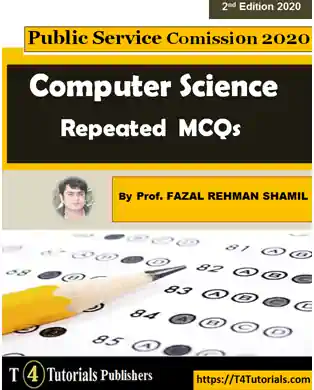Generations and History of computers MCQs is the set of important MCQs about computer history and generations.
Select the name of generation in which operating systems were built;
A. First
B. Third
C. Second
D. Fourth
Answer: Third
The processed form of data is called;
A. Field
B. Information
C. Words
D. File
Answer: Information
Machine language is
A. Difficult to program
B.Machine dependent
C. Error-prone
D. All of the above
Answer: All of the above
Fifth-generation computers are built on
A.System Knowledge
B.Programming Intelligence
C.Artificial Intelligence
D.VVLSI
E. None of these
Answer: Artificial Intelligence
Select the technology that is used in the First generation of computer;
A.Transistor
B.LSI
C.Vaccum Tube
D. VLSI
E.None of these
Answer: Vaccum Tube
Select the name of generation in which introduced Microprocessor;
A. Fourth Generation
B. Second Generation
C. Both (A) and (B)
D. Third Generation
E. All of these
Answer: Fourth Generation
Second-generation computers are manufacture of
A. Vaccum Tubes
B. LSI
C. Transistors
D. VLSI
E. None of these
Answer: Transistors
A computer contains
A. A central processing unit
B. A memory
C. Input and output unit
D. All of the above
Answer: All of the above
An integrated circuit is
A. A complicated circuit
B. Fabricated on a tiny silicon chip
C. Much costlier than a single transistor
D. An integrating device
Answer: Fabricated on a tiny silicon chip
Select the three decisions making actions performed by the ALU of a computer;
A. Less than
B. Grater than
C. Equal to
D. All of the above
Answer: All of the above
Select the name of generation in which Nepal conducts a computer for census of 2028 BS.
A. first generation
B. third generation
C. second generation
D. fourth generation
Answer: second generation
Select the purpose of the Algorithm and Flow chart;
A. Know the memory capacity
B. Specify the problem completely and clearly
C.Direct the output to a printer
D. Identify the base of a number system
Answer: Specify the problem completely and clearly
Select the year when Pascaline was originated;
A. 1617
B. 1642
C. 1620
D. 1837
Answer: 1642
Select Which one is the first computer to use keep Program Concept;
A. UNIVAC
B. EDSAC
C. ENIAC
D. None of the above
Answer: EDSAC
Once the user loads the acceptable program and provides need data, the computer does not need human intervention. This feature is known as
A. Accuracy
B. Reliability
C. Automatic
D. Versatility
Answer: Automatic
The interval of ________ generation was 1952-1964.
a) 1st
b) 2nd
c) 5th
d) 4th
Answer: 2nd
Select the number of major companies all over the world build microprocessors;
Only one company
B Three companies
C Tow companies
D Many companies
Answer: Two companies (Intel and Motorola)
Select the name of a generation that used Power-Book and Pentium microprocessor
A Third Generation
B Sixth Generation
C Fifth Generation
D Fourth Generation
Answer: Sixth Generation computer (1990 – till Now)
Select the name of a device that examines a direct entry input device;
A. Optical scanner
B. Light pen
C. Mouse and digitizer
D. All of the above
Answer: All of the above
Select the non-volatile memory;
A. SRAM
B. ROM
C. DRAM
D. All of the above
E. None of these
Answer: ROM
GUI abbreviation of;
A.Graph Use Interface
B.Graphical Universal Interface
C.Graphical Unique Interface
D.Graphical User Interface
E.None of these
Answer: Graphical User Interface
Any data or instruction entered into the memory of a computer is called
A.Storage
B.Input
C.Output
D.Information
E. None of these
Answer: Input
The time during which a job is prepared by the computer is:
A.Real Time
B.Delay Time
C.Execution Time
D.Waiting Time
E.None of these
Answer Execution Time
Select the circuit that is used as a ‘Memory device’ in computers;
A.Rectifier
B. Attenuator
C. Comparator
D. Flip Flop
E. None of these
Answer: Flip Flop
The fourth-generation was built on integrated circuits.
a) True
b) False
Answer True
The generation constructs on VLSI microprocessor.
a) 1st
b) 4th
c) 3rd
d) 2nd
Answer: 4th
Select the generation of computers started with using vacuum tubes as the primary components.
a) 3rd
b) 2nd
c) 1st
d) 4th
Answer: 1s
Select the generation in which Batch processing was mainly used;
a) 1st
b) 2nd
c) 3rd
d) 4th
Answer: 1st
Select the name of the generation in which Time sharing, Real-time, Networks, Distributed Operating System was used.
a) 1st
b) 4th
c) 5th
d) 2nd
Answer: 4th
HLL abbreviation of;
a) High Layman’s Language
b) High-Level Language
c) High-Level Lesson
d) High Layman’s Lesson
Answer: High-Level Language
Who is the founder of the computer?
A Charles Newman
B Henry Babbage
C Charles Babbage
D Henry luce
Answer: Charles Babbage
Select the example of a first-generation computer;
An ENIAC
B EDSAC
C EDVAC
D UNIVAC
Answer: ENIAC
Select the name of generation in which the Operating system is used the first time;
A First Generation
B Third Generation
C Second Generation
D Fourth Generation
Answer: Third Generation
Select the emerging branch in computer science, which explains the way and procedure of making computers think like human beings.
a) Blockchain
b) AI
c) VR
d) Cloud computing
Answer: AI
7 ULSI abbreviation of;
a) Ultra Lower Scale Integration
b) Under Lower Scale Integration
c) Ultra Large Scale Integration
d) Under Large Scale Integration
Answer: Ultra Large Scale Integration
Select the name of the generation that used CD ROM for the first time;
A First Generation
B Second Generation
C Third Generation
D Fourth Generation
E Fifth Generation computer
Answer: Fifth Generation computer (1983 1990)
